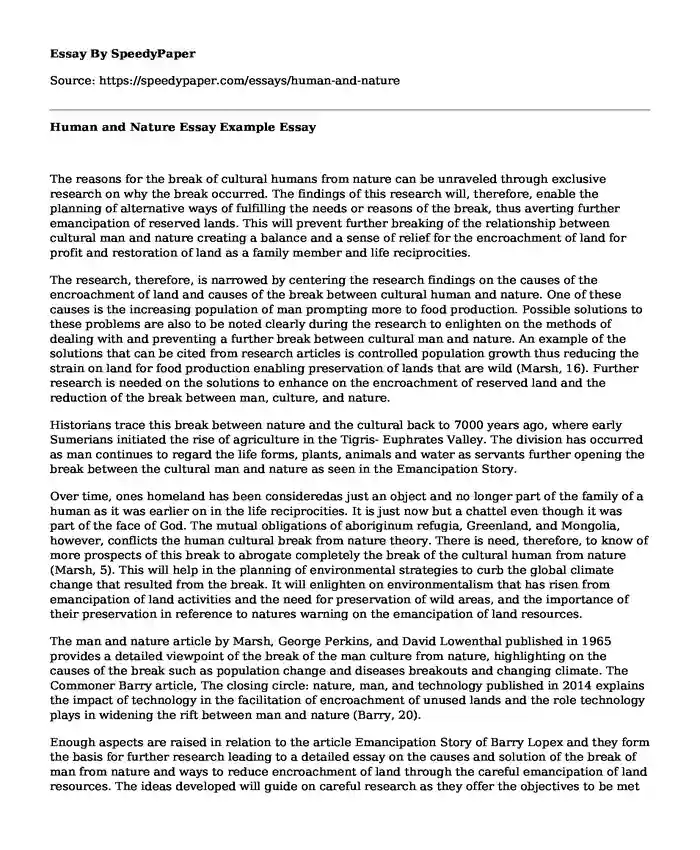The reasons for the break of cultural humans from nature can be unraveled through exclusive research on why the break occurred. The findings of this research will, therefore, enable the planning of alternative ways of fulfilling the needs or reasons of the break, thus averting further emancipation of reserved lands. This will prevent further breaking of the relationship between cultural man and nature creating a balance and a sense of relief for the encroachment of land for profit and restoration of land as a family member and life reciprocities.
The research, therefore, is narrowed by centering the research findings on the causes of the encroachment of land and causes of the break between cultural human and nature. One of these causes is the increasing population of man prompting more to food production. Possible solutions to these problems are also to be noted clearly during the research to enlighten on the methods of dealing with and preventing a further break between cultural man and nature. An example of the solutions that can be cited from research articles is controlled population growth thus reducing the strain on land for food production enabling preservation of lands that are wild (Marsh, 16). Further research is needed on the solutions to enhance on the encroachment of reserved land and the reduction of the break between man, culture, and nature.
Historians trace this break between nature and the cultural back to 7000 years ago, where early Sumerians initiated the rise of agriculture in the Tigris- Euphrates Valley. The division has occurred as man continues to regard the life forms, plants, animals and water as servants further opening the break between the cultural man and nature as seen in the Emancipation Story.
Over time, ones homeland has been consideredas just an object and no longer part of the family of a human as it was earlier on in the life reciprocities. It is just now but a chattel even though it was part of the face of God. The mutual obligations of aboriginum refugia, Greenland, and Mongolia, however, conflicts the human cultural break from nature theory. There is need, therefore, to know of more prospects of this break to abrogate completely the break of the cultural human from nature (Marsh, 5). This will help in the planning of environmental strategies to curb the global climate change that resulted from the break. It will enlighten on environmentalism that has risen from emancipation of land activities and the need for preservation of wild areas, and the importance of their preservation in reference to natures warning on the emancipation of land resources.
The man and nature article by Marsh, George Perkins, and David Lowenthal published in 1965 provides a detailed viewpoint of the break of the man culture from nature, highlighting on the causes of the break such as population change and diseases breakouts and changing climate. The Commoner Barry article, The closing circle: nature, man, and technology published in 2014 explains the impact of technology in the facilitation of encroachment of unused lands and the role technology plays in widening the rift between man and nature (Barry, 20).
Enough aspects are raised in relation to the article Emancipation Story of Barry Lopex and they form the basis for further research leading to a detailed essay on the causes and solution of the break of man from nature and ways to reduce encroachment of land through the careful emancipation of land resources. The ideas developed will guide on careful research as they offer the objectives to be met at the end of research such as causes of the break and solutions on ways of preservation of wild reserves of land and animals to reduce the break.
References
Marsh, George Perkins, and David Lowenthal. Man and nature. University of WashingtonPress, 1965.
Eiseley, Loren. The immense journey: An imaginative naturalist explores the mysteries of man and nature. Vintage, 2011.
Commoner, Barry. The closing circle: nature, man, and technology. Knopf, 2014.
Wallace, Alfred Russel. The Malay Archipelago: the land of the orang-utan and the bird of paradise; a narrative of travel, with studies of man and nature. Courier Corporation, 1869.
Cite this page
Human and Nature Essay Example. (2017, Aug 31). Retrieved from https://speedypaper.com/essays/human-and-nature
Request Removal
If you are the original author of this essay and no longer wish to have it published on the SpeedyPaper website, please click below to request its removal:
- Free Essay on Community Development
- Essay Example on the Future of Software Engineering
- Free Essay on Psychological Meaning of Emotions
- Essay Sample on Aspirin-exacerbated Respiratory Disease
- Poetry Essay Example: Themes in Poems by Bradstreet
- Free Paper with Questions and Answers on Organizational Behaviour and Development
- Essay Sample on How Much Freedom Should Parents Give to Their Children?
Popular categories





